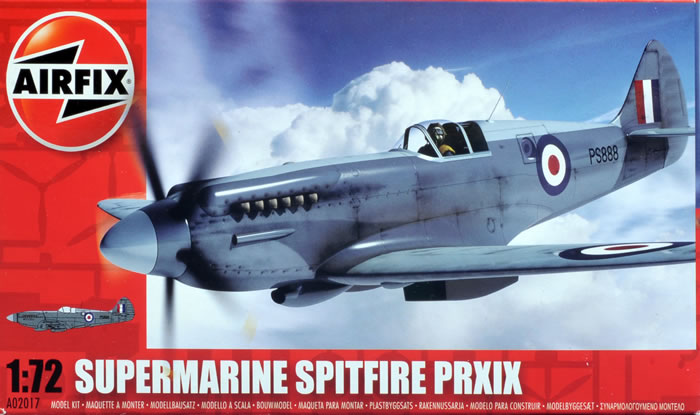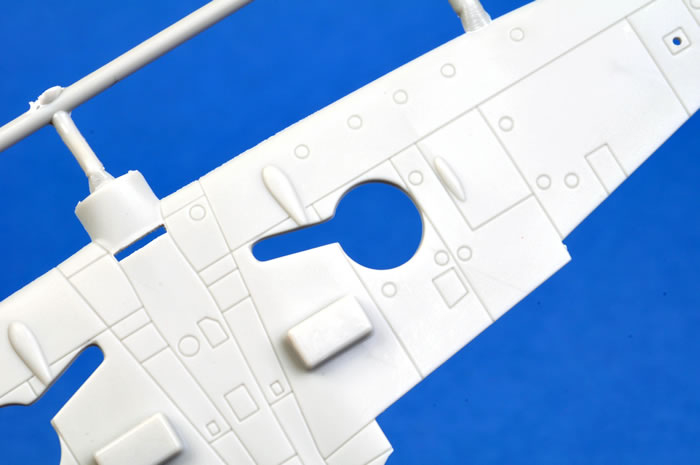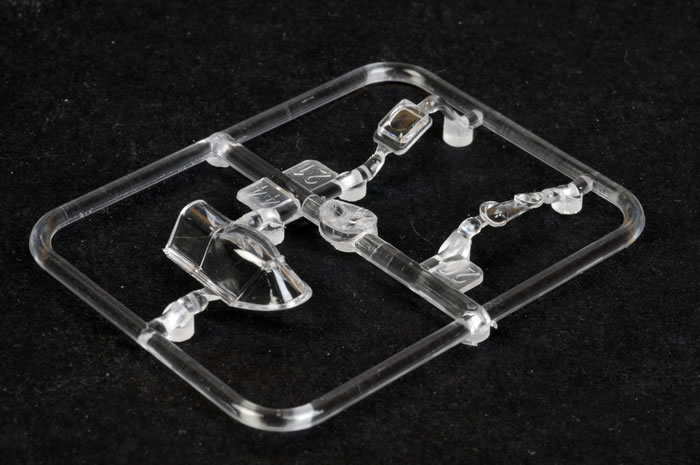|
Airfix 1/72 scale
Supermarine Spitfire PR.XIX

S
u m m a r y |
| Description and Catalogue Number: |
Airfix Kit # A02017 - Supermarine Spitfore PR.XIX |
| Scale: |
1/72 |
| Contents and Media: |
41 parts arranged on five sprues of soft grey styrene; 3 parts in clear styrene; decals for two subjects. |
| Price: |
From £4.95 available online from Hannants. Please note that the £30.00 overseas minimum does not apply to this kit. |
| Review Type: |
FirstLook |
| Advantages: |
Accurate outline, decent surface detail with engraved panel lines, Good instruction sheet. |
| Disadvantages: |
One-piece rather thick canopy, undernourished propeller and exhausts, un-boxed wheel wells, single piece landing gear. |
| Conclusion: |
A decent kit that has clearly been designed to a budget. |
Reviewed by Peter Mitchell

HyperScale is proudly supported by Squadron.com
The PR.XIX was the last of the photo reconnaissance Spitfires to see service. It was powered by the the 2050hp Rolls-Royce Griffon engine and was essentially the PR version of the Mk.XIV with the guns removed. This type saw service in the later days of the Second World War and was used by the RAF in Malaya. It was retired from RAF service in 1957. A total of 79 examples were built between November 1944 and May 1945.
This is the first completely new tool of a 1/72 Spitfire to be produced by Airfix in many decades. The last examples I can think of were the Mk1 and Mk V produced in the mid 1970’s.
The kit is packed in Airfix’s new, sturdy top opening box and contains the main parts and the transparencies separately bagged from each other. These are in turn wrapped in the instruction sheet and paint guide. The result is a snug, bulging package that won’t crush or damage easily.
The instructions are printed on three double sided A4 fold out sheets. These feature a short history of the Spitfire PR.XIX in five European languages, detailed construction sequence over 11 steps and also include a beautifully presented full colour paint and decal guide for the two versions offered. The colour call outs are provided for the Humbrol colour range.
The plastic parts are moulded in a soft light grey styrene, there is minimal flash, there are some minor shrinkage marks and the parts have thin sprue attachments. The surface detail is not as crisp as that seen on some kits coming from Asia and is rendered as engraved panel lines, there is not much in the way of rivet detail either. The engraving is a little heavy, but this ought to improve with some light sanding.

I am by no means a Spitfire expert, however Airfix have long had a reputation for producing 1/72 Spitfires with accurate outlines and they appear to have done a good job in capturing the refined lines of the late mark Griffon engined Spitfires with this kit. This was especially evident when comparing this kit’s parts with those of the Fujimi and “chunky” Academy Mk. XIV kits.
Construction starts with the main cockpit components; the kit offers the modeller a modicum of detail here, as the cockpit side walls have some basic representation of structure and instruments, the kit correctly provides no floor, simply a frame to support the rudder pedals and to connect the instrument panel frame to the rear frame supporting the seat and rear armour plate. The seat is a little thick and could be easily improved with a bit of a file down and there is a decent control column provided. The instrument panel has no detail at all, nor is a decal provided for the instruments. This is a surprising oversight and the modeller will have to make their own provisions in this area. A well detailed, but undersized pilot figure (boy?) with separate arms is also provided. This last item has got to be the first time in many years that I have seen a pilot figure offered with a modern tool of a kit.
All up the cockpit is a good try but it is crying out for further detailing. Having said that, the current level of detail provided here will not be clearly seen through the canopy that comes with the kit, for while it is quite clear, it is of one piece and is rather thick and distorting. The model would greatly benefit with a replacement.
The rest of the construction is quite straight forward; the propeller is a bit under nourished, being of insufficient thickness and chord. This could also do with replacement, Aeroclub perhaps.
The camera ports are filled with transparencies provided and these go into the hatch behind the cockpit and in two holes in the rear of the fuselage.

A solid plug for the aperture behind the cockpit is also provided, but not used on this kit. Its inclusion leads me to speculate that a Mk.XIV fighter is a future possibility from Airfix since they only need to replace the wing with a new mould.
The modeller has the choice of wheels up or down configurations and here we see another compromise in the form of a one piece moulding for the landing gear legs combined with the gear covers. This was another disappointing surprise and will require either careful painting or some simple surgery and replacement of the gear covers to get this area to look right. The wheel wells are unboxed and lack any detail.
Both three and four spoke wheels are provided.
The exhausts are separate items, but these too look a little on the thin side.
The decals appear to be well printed and are certainly an improvement on what Airfix has produced in the recent past. The detail is fine, the register is good, the colour tones are correct and the density seems OK. No stencils are provided, but I’m not sure the Spitfire PR.XIX had much in the way of stencils.

The modeller is given the choice of two simple but attractive options:
-
Spitfire PR.XIX, PS888. 81 Sqn. Royal Air Force, Malaysia, April 1954. Two tone Grey over PRU Blue with Type A roundels. It is likely that this aircraft should have large serial numbers under the wings, which are not included.
-
Spitfire PR.XIX, 31040. 1 Division Flottilj 11. Royal Swedish Air Force, Nykoping, July 1955. All over Grey with Swedish triple crown roundels, red spinner. It is probable that the crowns should have black outlines.
Good photo references of the a Swedish Mk.XIX (or J31) can be found in the August 1998 edition of IPMS Stockholm magazine online.
The new Airfix 1/72 scale Spitfire PR.XIX is a decent kit that has clearly been designed to a budget. Consequently there have been some compromises made with detail and finesse. Some of these, such as the undersized prop and exhausts, could have been avoided and these merely detract from the kit and make more “unnecessary” work for the modeller.
I expect this kit will go together well and to provide an accurate basis on which the modeller can make a very pleasing model. The super detailer could make it a master piece.
The “new” Airfix under Hornby are to be applauded for starting to make newly tooled kits.
Sample purchased locally by reviewer.
Text Copyright © 2009 by Peter Mitchell
Images Copyright © 2009 by Brett Green
Page Created 4 November, 2009
Last updated
4 November, 2009
Back to HyperScale Main Page |
